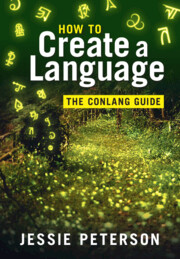Refine search
Actions for selected content:
91 results
The test of time: experimentally recreating the reanalysis of FINISH as a recent past marker
-
- Journal:
- Language and Cognition / Volume 18 / 2026
- Published online by Cambridge University Press:
- 19 December 2025, e2
-
- Article
-
- You have access
- Open access
- HTML
- Export citation
12 - Recombination, Feature Pool, and Population Structure
-
-
- Book:
- Uniformitarianism in Language Speciation
- Published online:
- 10 December 2025
- Print publication:
- 18 December 2025, pp 450-482
-
- Chapter
- Export citation
The Emergence of personne as a Negative Indefinite in Medieval and Pre-Classical French
-
- Journal:
- Journal of French Language Studies / Volume 35 / 2025
- Published online by Cambridge University Press:
- 15 December 2025, e25
-
- Article
-
- You have access
- Open access
- HTML
- Export citation
Breaking free from the be going to / gonna dichotomy? A study of variation in an emerging English modal
-
- Journal:
- English Language & Linguistics / Volume 29 / Issue 3 / September 2025
- Published online by Cambridge University Press:
- 20 November 2025, pp. 565-588
-
- Article
-
- You have access
- Open access
- HTML
- Export citation
16 - Historical Syntax
- from Part III - The Long View by Levels and Areas
-
-
- Book:
- The New Cambridge History of the English Language
- Published online:
- 30 October 2025
- Print publication:
- 30 October 2025, pp 545-610
-
- Chapter
- Export citation

How to Create a Language
- The Conlang Guide
-
- Published online:
- 23 October 2025
- Print publication:
- 02 October 2025
-
- Textbook
- Export citation
8 - Inflections and Grammaticalization
- from Part II - Constructing Grammar
-
- Book:
- How to Create a Language
- Published online:
- 23 October 2025
- Print publication:
- 02 October 2025, pp 149-171
-
- Chapter
- Export citation
En laat/dat ek nou net die koek laat val het! Laat-V1 constructions in Afrikaans
-
- Journal:
- Journal of Germanic Linguistics / Volume 37 / Issue 3 / September 2025
- Published online by Cambridge University Press:
- 02 October 2025, pp. 324-345
-
- Article
-
- You have access
- Open access
- HTML
- Export citation
The IPP-Effect in Afrikaans: Something Old, Something New
-
- Journal:
- Journal of Germanic Linguistics / Volume 37 / Issue 3 / September 2025
- Published online by Cambridge University Press:
- 02 October 2025, pp. 346-366
-
- Article
-
- You have access
- Open access
- HTML
- Export citation
Grammatical unidirectionality is not reflected in individual preferences when performing artificial semantic extension
-
- Journal:
- Language and Cognition / Volume 17 / 2025
- Published online by Cambridge University Press:
- 01 August 2025, e60
-
- Article
-
- You have access
- Open access
- HTML
- Export citation
Variation and change in the productivity of be going to V in the Corpus of Historical American English, 1810–2009
-
- Journal:
- English Language & Linguistics / Volume 29 / Issue 2 / June 2025
- Published online by Cambridge University Press:
- 25 June 2025, pp. 362-388
-
- Article
-
- You have access
- Open access
- HTML
- Export citation
Chapter 2 - The evolution of CPs: Theories, concepts and their relevance
-
- Book:
- Composite Predicates in English
- Published online:
- 09 May 2025
- Print publication:
- 15 May 2025, pp 18-26
-
- Chapter
- Export citation
16 - Gesture and Sign Language
- from Part III - Gestures and Language
-
-
- Book:
- The Cambridge Handbook of Gesture Studies
- Published online:
- 01 May 2024
- Print publication:
- 18 April 2024, pp 423-445
-
- Chapter
- Export citation
Chapter 2 - Theoretical and Methodological Considerations
-
- Book:
- Intensifiers in Late Modern English
- Published online:
- 15 March 2024
- Print publication:
- 28 March 2024, pp 9-34
-
- Chapter
- Export citation
5 - The Evolution of Connectives’ Meanings
-
- Book:
- Connectives and Discourse Relations
- Published online:
- 22 February 2024
- Print publication:
- 29 February 2024, pp 92-115
-
- Chapter
-
- You have access
- Open access
- HTML
- Export citation
8 - Teaching Chinese Modal Verbs
-
- Book:
- Cognitive Linguistics and Second Language Acquisition of Chinese
- Published online:
- 01 February 2024
- Print publication:
- 08 February 2024, pp 178-205
-
- Chapter
- Export citation
2 - Context in Historical Linguistics
- from Part I - Language in Context: A Sociohistorical Perspective
-
-
- Book:
- The Cambridge Handbook of Language in Context
- Published online:
- 30 November 2023
- Print publication:
- 14 December 2023, pp 49-70
-
- Chapter
- Export citation
Pseudo-Coordinated Sitzen and Stehen in Spoken German: A Case of Emergent Progressive Aspect?
-
- Journal:
- Journal of Germanic Linguistics / Volume 35 / Issue 4 / December 2023
- Published online by Cambridge University Press:
- 29 November 2023, pp. 447-486
-
- Article
-
- You have access
- Open access
- HTML
- Export citation
3 - Pragmatic Markers
-
- Book:
- Pragmatics in the History of English
- Published online:
- 28 September 2023
- Print publication:
- 12 October 2023, pp 44-71
-
- Chapter
- Export citation
8 - Language Change
- from III - The Mental Grammar, Language Universals, and Language Change
-
- Book:
- A Mind for Language
- Published online:
- 13 October 2023
- Print publication:
- 21 September 2023, pp 251-290
-
- Chapter
- Export citation
